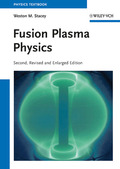Fusion Plasma Physics

2. Auflage August 2012
XVIII, 648 Seiten, Hardcover
191 Abbildungen (1 Farbabbildungen)
13 Tabellen
Lehrbuch
Kurzbeschreibung
A new edition of this established introduction, unique in keeping the balance between fundamentals in plasma physics and more advanced concepts in nuclear fusion.
Jetzt kaufen
Preis: 132,00 €
Preis inkl. MwSt, zzgl. Versand
Euro-Preise für Wiley-VCH- und Ernst & Sohn-Titel sind nur für Deutschland gültig. In EU-Ländern gilt die lokale Mehrwertsteuer. Portokosten werden berechnet.
- Gedruckte Ausgabe vergriffen -
This revised and enlarged second edition of the popular textbook and reference contains comprehensive treatments of both the established foundations of magnetic fusion plasma physics and of the newly developing areas of active research. It concludes with a look ahead to fusion power reactors of the future. The well-established topics of fusion plasma physics -- basic plasma phenomena, Coulomb scattering, drifts of charged particles in magnetic and electric fields, plasma confinement by magnetic fields, kinetic and fluid collective plasma theories, plasma equilibria and flux surface geometry, plasma waves and instabilities, classical and neoclassical transport, plasma-materials interactions, radiation, etc. -- are fully developed from first principles through to the computational models employed in modern plasma physics.
The new and emerging topics of fusion plasma physics research -- fluctuation-driven plasma transport and gyrokinetic/gyrofluid computational methodology, the physics of the divertor, neutral atom recycling and transport, impurity ion transport, the physics of the plasma edge (diffusive and non-diffusive transport, MARFEs, ELMs, the L-H transition, thermal-radiative instabilities, shear suppression of transport, velocity spin-up), etc. -- are comprehensively developed and related to the experimental evidence. Operational limits on the performance of future fusion reactors are developed from plasma physics and engineering constraints, and conceptual designs of future fusion power reactors are discussed.
2. Motion of Charged Particles.
3. Magnetic Confinement.
4. Kinetic Theory.
5. Fluid Theory.
6. Plasma Equilibria.
7. Waves.
8. Instabilities.
9. Neoclassical Transport.
10. Plasma Rotation.
11. Turbulent Transport.
12. Heating and Current Drive.
13. Plasma-Material Interactions.
14. Divertors.
15. Plasma Edge.
16. Neutral Particle Transport.
17. Power Balance.
18. Operational Limits.
19. Fusion Reactors and Neutron Sources.
Appendices
A: Frequently Used Physical Constants.
B: Dimensions and Units.
C: Vector Calculus.
D: Curvilinear Coordinates.
E: Plasma Formulas.
F: Further Reading.
G: Attributions.


